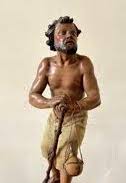
STOLEN ROYAL CRIB FIGURE RETURNED
Just in time for the 2023 Christmas festivities, Italy's crack heritage police force (Carabinieri del Nucleo Tutela Patrimonio Culturale – Naples branch) have recovered the missing figurine of a beggar, stolen during the 1980s from the royal Presepio (Nativity Crib) at the Palace of Caserta (Naples). The perfectly modelled figure was part of the celebrated artistic Christmas Crib set up inside the palace by the Bourbon monarchs in the 18th century.
The monumental Presepio contains over a thousand terracotta figures, all modelled by hand. Leading artists of the period, such as sculptors Matteo Bottiglieri and Giuseppe Sanmartino (author of the celebrated “Veiled Christ”), contributed to the creation of the court Crib while many figurines were clothed by the royal princesses and their ladies, who sewed the garments of the leading characters with silk spun at the royal silk factory in nearby San Leuca and adorned them with coral and gem stones. The more humble characters, which represent the ordinary people of Naples of the period, such as fishermen, washerwomen, stallholders, innkeepers, shepherds, cobblers, card players and so on are set up to recreate an image of bustling 18th century daily life, grouped around the grotto of the Holy Family, set under a rugged cliff of cork.
The Presepio tradition has a long, fascinating and honoured history in Naples. The Neapolitan Nativity scene follows strict rules, with a number of essential characters with double meanings, such as the Sleeping Shepherd boy, Benino, who symbolizes re-awakening, the bridge over running water that represents the passage between life and death, Ciccio Bacco, the wine seller, is the personification of the old pagan god, Bacchus, the Gypsy woman with child is the embodiment of maternity and the Three Wise Men are also Night, Mid-day and Dawn.
Info: Tel. +39.0823.448084 www.reggiadicaserta.cultura.gov.it
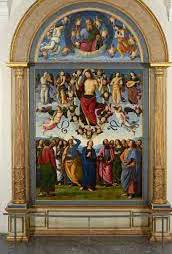
PERUGINO MASTERPIECE REUNITED IN PERUGIA
2023, the 500th centenary of the death of the great Renaissance painter Pietro Vannucci – better known as Perugino - gives art lovers a unique opportunity to see one of the artist's most amazing masterpieces in its original form and setting. The magnificent centrepiece of the polyptych featuring the Ascension of Christ is at present on show in the Abbey Church of San Pietro in the artist's birth town of Perugia, on loan from the Musée des Beaux-Arts of Lyon in France.
The monumental polyptych, which originally covered the wall behind the main altar, was dismantled during restructuring work on the church at the end of the 16th century. In 1797, at the time of the Napoleonic occupation of Italy, it became part of the war plunder of Italian works of art. Divided into eleven parts, it was taken to France and ended up in the collections of the Fine Arts Museums of Rouen, Nantes and Lyon. Only five small panels from the predella (a raised shelf at the bottom of the polyptych) remained in the church's possession.Subsequent negotiations by Antonio Canova after the fall of Napoleon, achieved the transfer of some other sections to the Vatican Museum.
The Cathedral of San Pietro is one of the most richly decorated religious house in Italy, with the walls of the interior entirely covered with a stunning display of renaissance paintings and grotesques. But these are not the only impressive works of art that this exclusive (and little known) church possesses. Its carved wooden choir, designed by Raphael, is hailed as the most beautiful of its type in Italy. It possesses Italy's oldest organ, dating from 1463, famed for the quality of its acoustics. It also features one of the world's largest paintings: an “Apotheosis of the Benedictine Order” by Antonio Vassilacci, who also decorated much of the Doge's Palace in Venice. This work measures around 90 sqm and occupies the entire wall above the entrance door and features a bewildering mass of over 300 larger-than-life figures.
A registered Italian National Monument, St. Peter's abbey was founded in 965 and built on the ruins of an earlier church that in turn occupied an ancient Etruscan-Roman sacred site. The Cathedral.is tucked in a corner of the former vast monastic complex of the Benedictines, which, with typical Italian quirky nonchalance, has now become part of the local Faculty of Agronomy.
On show until the 7th January 2024.
M. STENHOUSE
Info: Tel. +39.075.33753 www.fondazioneagraria.it
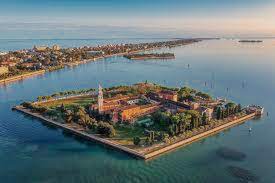
VENICE CAPITAL OF SUSTAINABILITY
United \Nations Office for Disaster Risk Reduction (UNDAR) has paid an official tribute to the efforts made by Venice to preserve the ecosystem of its lagoon and reduce the “Acqua Alta” phenomenon of recurrent flooding of the city centre.
Venice's construction of the revolutionary Mose Barrier across the lagoon has been hailed a success in reducing this problem. The Mose (in Italian this is pronounced the same as the name of the Old Testament prophet who parted the waters of the Red Sea to let his people escape from the pursuing Egyptians, but more prosaically it is actually an acronym for Modulo Sperimentale Elettromeccanico.
Venice has also announced plans to protect the ecosystem of the two sandbank islands in the lagoon, known as the Lazzaretti, as for centuries they were Quarantine centres for plague sufferers with the first hospital founded in 1423. These islands are to be promoted as an important part of the Venetian historic hospital museum system, as announced during the recent Festival of the History of Health, held between the 8th -17th November 2023.
M. STENHOUSE
Info: Tel. +0039.041.5294323 www.scuolagrandesanmarco.it scuolagrandesanmarco@aulss3.veneto.it
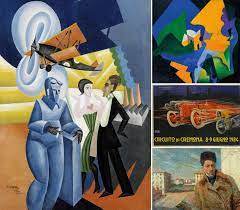
FUTURISM MAKING A COMEBACK
After almost a century of neglect, the Futurism Art movement, which flourished during the early years of the nineteen hundreds, is enjoying a tardive revival.
The Futurism Movement was founded in Italy in 1909 by editor, poet and artist Filippo Tommaso Martinelli. It embraced progress and innovation, especially in the mechanical and industrial fields. Many of the Futurists were obsessed with the scientific discoveries that characterized the age. They rejected history studies and the art of the past and preferred subjects like motor cars, trains, aeroplanes and skyscraper city-scapes.
The Movement fell into disfavour because of its association with Fascism. Its use of bright primary colours and bold, dynamic forms has had, nonetheless, an enormous impact on modern design, graphic art, advertising, films and video games.
This autumn several exhibitions are dedicated to Futurist artists and trends: Matera (Basilicata) is holding an important show until the 10th January 2024 where it explores the contribution of the Mezzogiorno (Southern Italy) artists to the Movement.
Treviso (Veneto) offers two exhibitions under the title: “Futurism on Paper” with “Avant-guard Forms” running till the 25th February 2024, followed by “Imagine the Universe with the art of Publicity”, on from 1st March till 30th June 2024. The exhibition “Umberto Boccioni prima del Futurismo” at the Villa Mamiano di Traversetolo (Parma, Emilio Romagna) until the 10th December 2023) explores the art of the painter and sculptor Boccioni whose images and distorted anatomical forms were an important inspiration for the avant-guard Futurist Movement.
Meanwhile in Milan until the 2nd December visitors can make close acquaintance with “Aeropittura Futurista”, a later movement of Futurism that focussed on flight and aerial landscapes.
Info: Tel. +39.049.663499 www.studioesseci.net
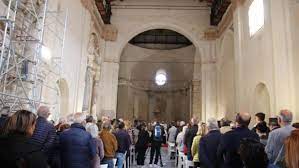
SLOW REBIRTH OF EARTHQUAKE TOWNS
The Church of St.Benedict of Norcia recently held its first religious service seven years after the catastrophic earthquake that devastated parts of central Italy in 2016. The faithful met under the newly restored roof in a building, however, still full of scaffolding and an estimated further two years will be needed to restore the church to something approaching its former glory.
St. Benedict, the patron saint of Europe, was born in Norcia, which is therefore an important centre of religious tourism. The town is also famous for its pork butchers and in pre-earthquake times its restaurants and food shops were packed at weekends with diners and shoppers.
The surrounding area, which is largely mountainous, was very badly damaged. 138 villages and hamlets were involved and some 14,000 families are still living in temporary housing. The first mass in Norcia was greeted as a sign on hope that things may now gradually return to normal after the interminable rebuilding delays.
The town of Amatrice, another pre-quake tourist centre, is also celebrating the return of a beloved landmark - the 27m-high medieval clock-tower that rises in the heart of the town. The clock hands had frozen at the fatal hour of 3.36 on the 24th August 2016, when the violent earth tremor struck, reducing the town centre to rubble. The tower has now been restored and reinforced and the clock has resumed its normal time-honoured task of centuries-long time-keeping.
-
STENHOUSE.
Info: www.comune.norcia.pg.it www.comune.amatrice.rieti.it
SLOW REBIRTH OF EARTHQUAKE TOWNS
The Church of St.Benedict of Norcia recently held its first religious service seven years after the catastrophic earthquake that devastated parts of central Italy in 2016. The faithful met under the newly restored roof in a building, however, still full of scaffolding and an estimated further two years will be needed to restore the church to something approaching its former glory.
St. Benedict, the patron saint of Europe, was born in Norcia, which is therefore an important centre of religious tourism. The town is also famous for its pork butchers and in pre-earthquake times its restaurants and food shops were packed at weekends with diners and shoppers.
The surrounding area, which is largely mountainous, was very badly damaged. 138 villages and hamlets were involved and some 14,000 families are still living in temporary housing. The first mass in Norcia was greeted as a sign on hope that things may now gradually return to normal after the interminable rebuilding delays.
The town of Amatrice, another pre-quake tourist centre, is also celebrating the return of a beloved landmark - the 27m-high medieval clock-tower that rises in the heart of the town. The clock hands had frozen at the fatal hour of 3.36 on the 24th August 2016, when the violent earth tremor struck, reducing the town centre to rubble. The tower has now been restored and reinforced and the clock has resumed its normal time-honoured task of centuries-long time-keeping.
-
STENHOUSE.
Info: www.comune.norcia.pg.it www.comune.amatrice.rieti.it
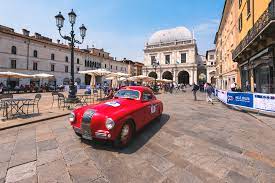
BRESCIA READIES FOR 2024 MILLE MIGLIA
The 2024 itinerary of the mythical Mille Miglia race was presented recently in Brescia (Lombardy), where the very first edition was held in 1927. The five-day historic car race is an eagerly-awaited event exclusive to motor cars built before 1957 that have participated in at least one race between 1927 and 1957. The event was banned in 1938 for a twenty-year interval after several spectators were killed in a crash during the race.
The 42nd edition of the “Thousand Mile” itinerary between Brescia-Rome and back is divided into five-day stages and touches many cities in north and central Italy. This year's itinerary includes Genoa for the first time and follows an anti-clockwork route through seven Italian regions between the 11th - 15th June 2024. 400 cars have already signed up to compete. The Mille Miglia race was launched in Brescia and the town continues to be strongly identified with the event. Brescia also has a dedicated Museum, situated inside the converted medieval Monastery of Sant'Eufemia della Fonte at the town gate.
Info: Tel. +39.030.3365631 segreteria@museomillemiglia.it
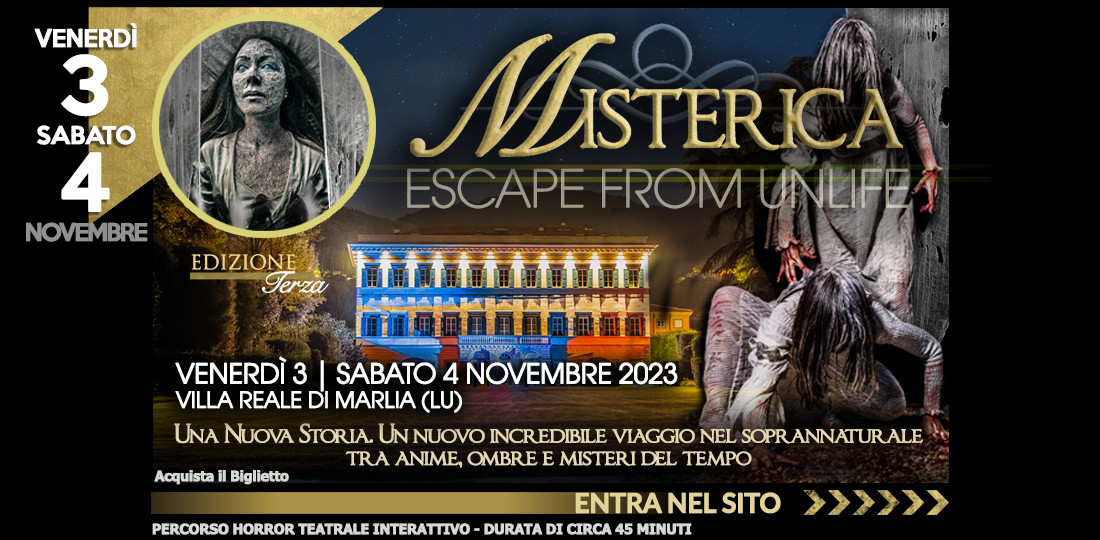
HALLOWE'EN EXTRAVAGANZA IN GARFAGNANO
The biggest Hallowe'en party in Italy is centred round the medieval village of Borgo a Mozzano in the Garfagnano Valley (Lucca, Tuscany) where some 40,000 thousand participants invade the narrow streets to enjoy the non-stop festive programme of street artists, circus acrobats, music performances and historical reenactments all centred around the traditional theme of witches, ghosts, ghouls, vampires and other undesirables from the Underworld, according to the Hallowe'en tradition, imported in recent years from the ancient world of the Celtic peoples.
Borgo a Mozzano is known for its Bridge of the Devil (officially called the Bridge of the Magdalene) that arches high over the Serchio River, while Lucca is haunted by its local ghost - Lucida Mansi, a 17th century noblewoman who made a pact with the devil to retain her youth and beauty in exchange for her soul. Poor Lucida was no match for the Devil, who cheated her and she ended up drowning herself in despair.
Many events also take place in the nearby Royal Palace of Marlia in Lucca, once residence of Napoleon's sister Elisa whom he nominated Princess of Lucca.
Keeping in with the theme of the party, the historic Nardini distillers of Fornaci di Barga (also in the Garfagnano Valley) have produced a special Hallowe'en “Diabolik Drink”, available in the street food stands.
The 2023 Hallowe'en Night at Borgo a Mozzano lasts over two weekends of revelry, from the 28th - 31st October and the 3rd-4th November.
Info: Tel. +39.0584.581938/349.3238249 info@halloweenborgo.it
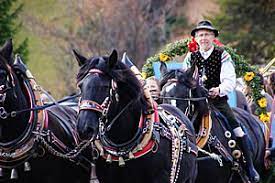
RIDE WITH SAN LEONARDO AT ALTA BADIA
The San Leonardo Ride is a highlight of the autumn season in the charming mountain villages of Alta Badia (Bolzano, South Tyrol) in the Dolomite mountain range. St. Leonard is the patron saint and every year his feast day is celebrated with a colourful procession of citizens and farmers in traditional costume, riding the local Haflinger and Norica horses.
This exclusive breed is an integral part of the culture of the area, where these sturdy and placid-natured animals adapt to all kinds of tasks, from pulling carts on farms to trekking trips with children. In their free time, the horses are left free to graze on the mountain pastures.
The Feast of St. Leonard is programmed for the 5th November 2023 and over a hundred riders and breeders will flock to Alta Badia for the event, which includes the blessing of the horses at the Church of San Leonardo, followed by a long procession through the valley villages with band music, dancers and the gastronomic specialities of the region. This year, for the first time, the event will be partnered by the Verona Horse Fair (9-12 November), the most important horse fair in Italy.
A special highlight of the Feast will be the dashing joust dedicated to the one-eyes medieval overlord Oswald von Wolkenstein, a local warrior, poet, singer and writer
Info: Tel. +39.0471.836176 www.alta-badia.org
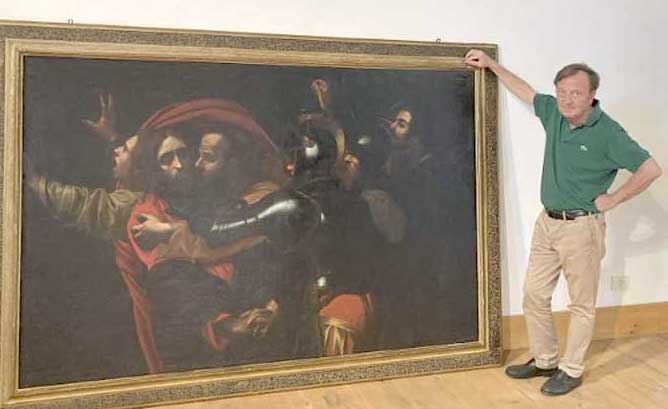
CARAVAGGIO “RE-FOUND”
Francesco Petrucci, curator of the Palazzo Chigi Museum in the town of Ariccia, some 27 kilometres south of Rome in the hilltop area of the Castelli Romani, has scooped an exclusive first, with the exhibition of a long lost 17th century Caravaggio “Presa di Cristo” (Christ's Capture), on view to the public for the first time
Like so many “lost” Italian works of art, the painting has had an obscure and chequered history, before it was finally purchased by the late Rome art dealer, Mario Bigetti in 2003. For years it was the subject of controversy and discussion among experts. It was known that Caravaggio authorized several copies of his most popular works to meet patrons' demands, most made in his bottega by his assistants, but Petrucci, who is a leading expert on Baroque art, suspected that this particular version was an authentic work by the Master himself, pre-dating the celebrated painting on the same theme in the Dublin National Gallery collection.
Other prominent Caravaggio experts, including the late British art historian Sir Denis Mahon, as well as the Italian art specialists Claudio Strinati and Mina Gregori had also examined the painting and unanimously agreed that it was unmistakeably a first version of the Caravaggio masterpiece, painted personally by the artist. The hunch was subsequently confirmed during the subsequent extensive restoration process which revealed details and typical repentimenti in the artist's unmistakeable hand.
The painting was commissioned by the nobleman Ciriaco Mattei in 1606, as proved by the payment document in the family archives, and was subsequently passed to various owners till it was ultimately rediscovered in the National Gallery of Odessa.
The dramatic moment of Jesus' arrest is rendered in Caravaggio's unmistakeable masterly use of chiaroscuro, with the gleaming armour of the soldiers in contrast with the dark figure of Judas and the dull red robe of Christ. The profile of a man in the top right hand corner is believed to be a self-portrait of Caravaggio himself.
The Chigi Palace of Ariccia contains one of the most important collections of Roman Baroque art, donated by eminent collectors such as Fabrizio and Fiammetta Lemme (who contribute 128 works alone), Maurizio Fagiolo dell'Arco, Lascera, Ferrari and the late-lamented antiquarian Ferdinando Peretti, founder of the Walpole Gallery in London.
This is not an only “first” for Petrucci, who successfully identified a “lost” marble bust of Pope Paul V in Bratislava, Slovakia as the work of Gianlorenzo Bernini that had disappeared after the Borghese family had put it up for auction in 1893.
In addition to the exhibition, visitors can take the opportunity to explore the rooms of the Chigi Palace museum, which contains the original furniture, paintings and decorations of a princely house of the past.
The exhibition runs until the 7th January 2024
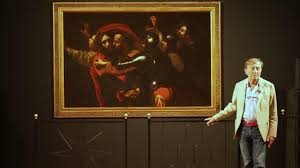
CARAVAGGIO “RE-FOUND”
Francesco Petrucci, curator of the Palazzo Chigi Museum in the town of Ariccia, some 27 kilometres south of Rome in the hilltop area of the Castelli Romani, has scooped an exclusive first, with the exhibition of a long lost 17th century Caravaggio “Presa di Cristo” (Christ's Capture), on view to the public for the first time
Like so many “lost” Italian works of art, the painting has had an obscure and chequered history, before it was finally purchased by the late Rome art dealer, Mario Bigetti in 2003. For years it was the subject of controversy and discussion among experts. It was known that Caravaggio authorized several copies of his most popular works to meet patrons' demands, most made in his bottega by his assistants, but Petrucci, who is a leading expert on Baroque art, suspected that this particular version was an authentic work by the Master himself, pre-dating the celebrated painting on the same theme in the Dublin National Gallery collection.
Other prominent Caravaggio experts, including the late British art historian Sir Denis Mahon, as well as the Italian art specialists Claudio Strinati and Mina Gregori had also examined the painting and unanimously agreed that it was unmistakeably a first version of the Caravaggio masterpiece, painted personally by the artist. The hunch was subsequently confirmed during the subsequent extensive restoration process which revealed details and typical repentimenti in the artist's unmistakeable hand.
The painting was commissioned by the nobleman Ciriaco Mattei in 1606, as proved by the payment document in the family archives, and was subsequently passed to various owners till it was ultimately rediscovered in the National Gallery of Odessa.
The dramatic moment of Jesus' arrest is rendered in Caravaggio's unmistakeable masterly use of chiaroscuro, with the gleaming armour of the soldiers in contrast with the dark figure of Judas and the dull red robe of Christ. The profile of a man in the top right hand corner is believed to be a self-portrait of Caravaggio himself.
The Chigi Palace of Ariccia contains one of the most important collections of Roman Baroque art, donated by eminent collectors such as Fabrizio and Fiammetta Lemme (who contribute 128 works alone), Maurizio Fagiolo dell'Arco, Lascera, Ferrari and the late-lamented antiquarian Ferdinando Peretti, founder of the Walpole Gallery in London.
This is not an only “first” for Petrucci, who successfully identified a “lost” marble bust of Pope Paul V in Bratislava, Slovakia as the work of Gianlorenzo Bernini that had disappeared after the Borghese family had put it up for auction in 1893.
In addition to the exhibition, visitors can take the opportunity to explore the rooms of the Chigi Palace museum, which contains the original furniture, paintings and decorations of a princely house of the past.
The exhibition runs until the 7th January 2024
<< Previous 1 2 3 4 5 6 7 8 9 10 11 12 13 14 ... 16 ... 18 ... 20 ... 22 ... 24 ... 26 ... 28 ... 30 ... 32 ... 34 ... 36 ... 38 ... 40 ... 42 ... 44 ... 46 ... 48 ... 50 ... 52 ... 54 ... 56 ... 58 ... 60 ... 62 ... 64 ... 66 ... 68 ... 70 ... 72 ... 74 ... 76 ... 78 ... 80 ... 82 ... 84 ... 86 ... 88 ... 90 ... 92 ... 94 ... 96 ... 98 ... 100 ... 102 ... 104 ... 106 ... 108 ... 110 ... 112 ... 114 ... 116 ... 118 ... 120 ... 122 ... 124 ... 126 ... 128 ... 130 ... 132 ... 134 ... 136 ... 138 ... 140 ... 142 ... 144 ... 146 Next >>



